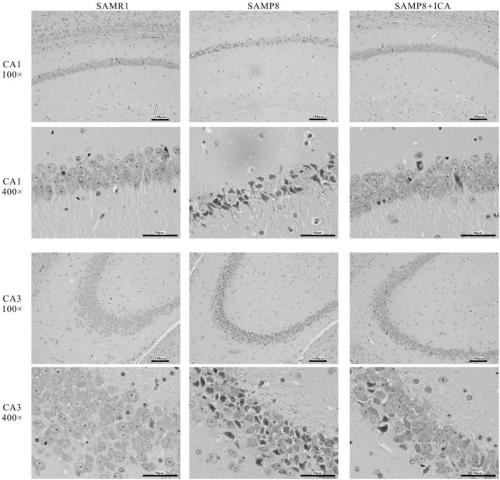Application of icariin in preparation of medicine for preventing and treating Alzheimer's disease
A technology for Alzheimer's disease and icariin, applied in the field of medicine, can solve problems such as the incomplete understanding of the molecular mechanism of the nervous system, and achieve the effects of reducing deposition, increasing the ratio, and inhibiting neuron apoptosis
- Summary
- Abstract
- Description
- Claims
- Application Information
AI Technical Summary
Problems solved by technology
Method used
Image
Examples
Embodiment 1
[0030] Embodiment 1Morris water maze experiment
[0031] The Morris water maze test was used to evaluate the spatial learning and memory abilities of the mice. The Morris water maze consists of a black circular pool (120 cm in diameter and 50 cm in depth) divided into four quadrants. The water temperature was maintained at 23±1°C and made opaque by adding titanium dioxide. The camera is placed about 2m above the center of the pool to automatically collect images of animal swimming trajectories, and the collected signals are directly input into the computer, which is automatically analyzed and processed by the automatic collection and analysis system that comes with the device.
[0032] The Morris water maze experiment consists of two parts, the hidden platform test and the space search test. The concealed platform test was carried out from the 18th day to the 21st day after ICA administration. A platform was placed in the third quadrant, and the animal was gently put into th...
Embodiment 2
[0033] Example 2 Hematoxylin-eosin (HE) staining
[0034] For hematoxylin-eosin (HE) staining, brain tissue was fixed in paraformaldehyde for one week, sectioned through the hippocampus and immersed in paraformaldehyde. Then, the paraffin samples were made into a series of slices with a thickness of 4 μm, and placed in a water bath to fully expand. The unfolded slices were placed at 60°C for 4 hours for fixation. Then dewax with xylene, dehydrate with graded alcohol, stain with hematoxylin for 1 minute, rinse with tap water, place in 1% hydrochloric acid alcohol differentiation solution for 5 seconds, treat with 1% ammonia water, and stain with eosin. After the sections were dehydrated with graded alcohol, they became transparent in xylene and sealed in neutral glue. Histopathological changes were observed with an Olympus microscope (BX60; Olympus, Japan), and the experiment was repeated three times.
Embodiment 3
[0035] Example 3 Immunohistochemical Analysis
[0036] Immunohistochemistry was performed according to standard procedures. Briefly, sections of the hippocampus from each mouse were sectioned in parallel, cut into 6 μm thick sections, and mounted onto silane-coated glass slides. Sections were boiled in 0.01 M citrate buffer (pH 6.0) for 10 minutes and then rinsed with PBS. Endogenous peroxidase was blocked with methanol containing 0.3% hydrogen peroxide for 20 min, blocked with 5% goat serum and 0.3% TritonX-100 in PBS, and then blocked with primary antibody Aβ1-42 (1 :200) overnight, then washed and incubated with anti-rabbit secondary antibody (1:10000) for 1 hour. Cells were observed with a confocal microscope (FV1000, Olympus, Japan). Six to 10 slices of the hippocampus of each mouse were selected for imaging and analysis.
PUM
 Login to View More
Login to View More Abstract
Description
Claims
Application Information
 Login to View More
Login to View More - R&D
- Intellectual Property
- Life Sciences
- Materials
- Tech Scout
- Unparalleled Data Quality
- Higher Quality Content
- 60% Fewer Hallucinations
Browse by: Latest US Patents, China's latest patents, Technical Efficacy Thesaurus, Application Domain, Technology Topic, Popular Technical Reports.
© 2025 PatSnap. All rights reserved.Legal|Privacy policy|Modern Slavery Act Transparency Statement|Sitemap|About US| Contact US: help@patsnap.com



